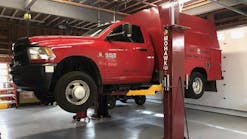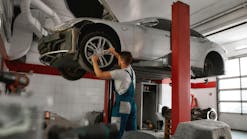The pandemic's impact on business practices
Content brought to you by Motor Age. To subscribe, click here.
What you'll learn:
- Business practices implement because of COVID that are worth keeping
- How to use a SWOT analysis to decide what is best for your business
As we continue to move beyond the pandemic to what some would call the “new normal,” I’m sure there are certain practices you can’t wait to get rid of and eye-opening opportunities you prefer to keep. Personally, I really enjoy ordering curbside pickup at my local grocery store; pulling into a designated parking spot and having someone place the groceries in my trunk is so convenient. I almost feel guilty since I am healthy enough to go inside and do it on my own, but then I catch myself hoping that this service never goes away. Of course, curbside pickup is something my grocery store could have offered all along, but it took a pandemic to bring about this value-added service offering.
It got me thinking about shop owners and what areas of their businesses had to be adapted or strengthened to survive the pandemic. When COVID isn’t an issue anymore, how would they evaluate which services should go, which should stay, and which should possibly improve? Then, I remembered a coaching method I use with my members to help them make such decisions. I tell them to ask themselves three questions that each require the answer “YES”; they are:
Is it good for the car?
Is it good for the customer?
Is it good for us?
Disinfecting and sanitizing
When the pandemic first hit, we learned that sanitizing everything was important for reducing the spread of the COVID virus and protecting the health of others. So we sprayed or wiped the surfaces of everything we touched. Some of us even purchased ultraviolet lights and ozone generators to kill anything lurking in the building or customers’ vehicles. This got me thinking: I don’t know how many of my customers, or maybe a family member that lives with them, may have a compromised immune system.
This heightened awareness of how germs and viruses spread also has me thinking about cold and flu season. I believe auto shop owners should keep and promote their infection control practices and offer disinfecting services during cold and flu season: disinfect interior surfaces along with the ventilation system, replace the cabin filter, and ozonate the vehicle. This disinfection service would be valuable to customers who have a new definition of “clean” and understand the importance of killing germs to protect themselves and others.
Touchless transactions
Other practices worth keeping are touchless transactions. As shop owners realized the pandemic would not be a two-week isolation period, they knew they had to develop safer processes. Therefore, what used to be called the “Early Bird” drop box became the new service counter. Now, everyone has lock boxes on the side of the building for customers to drop off and pick up keys to their vehicles. They also added the touchless payment process, making text-to-pay service popular overnight. Customers can pay at any time without touching your credit card machine or the service advisor’s pen during the process.
Shop owners quickly learned that they could do business with their customers virtually 24 hours a day, seven days a week. Customers became comfortable dropping off, paying, and picking up their vehicles without ever stepping into the shop resulting in more flexible scheduling options for auto shop staff. Many shops added a second shift to keep some of their team isolated if there was an outbreak on another shift. They also found many productivity benefits resulting from scheduling this way.
Concierge services
Prior to COVID, when I would ask my members if they provided concierge services, they would all say “yes.” But the reality was their services were limited and not well-promoted. The onset of COVID forced them to expand those limits to include drop-off and pickup. Services now included going to the customer’s home or work to pick up their vehicle, performing repair services at the shop, and returning the vehicle to the customer. Those shop owners and service writers received positive customer feedback, sincere appreciation, and loyalty for providing this level of service.
Convenience is everything to consumers today. Some of us are old enough to remember when a small company named Domino’s started delivering pizzas to your front door. Delivery revolutionized the pizza industry, and now almost every pizza shop offers it. Some auto shop owners are already building this mobile service model today to offer their customers.
Social media usage
Another challenge addressed was how to keep in touch with customers when they’re not leaving the house. Social media usage became more popular as shop owners sought cost-effective ways to keep customers informed about when they were open for business and changes in service delivery. They had a captive audience because everyone was quarantined at home, bored, and scanning social media for hours just like their teenage kids. Without these social media updates, some businesses may not be here today.
When the Colonial Pipeline cyber attack happened, gas stations relied on social media to inform customers when they received gas and when they were out. Many station owners received compliments for letting their customers know in advance, so they weren’t waiting needlessly in long lines and getting frustrated. Being transparent and sharing gas availability and service wait times on social media made surviving this challenge easier for both station owners and customers.
Community-focused marketing
Marketing had to be adapted to be more community-focused and empathetic. I was so proud of the shops offering specials for first responders and asking parts vendors to come along for the ride. I think there is always an opportunity to acknowledge people in our community who serve. I’m sure everyone has heard someone complaining about how rough it was being confined to their house and working from home, while essential workers (a.k.a. heroes) were putting their health on the line and going out into the unknown to perform services for the greater good. We should continue to acknowledge them and always strive to take care of these special people.
Cross-promotion marketing was also revitalized. Everyone probably knows a restaurant owner or employee who struggled or didn’t survive. Many shop owners partnered with other businesses in the community to cross-promote and support each other’s services. For example, giving your customer a gift card for a local restaurant and that same restaurant giving a gift card for the shop helped promote and expose your business to new customers. Cross-promotion was an effective way to keep vehicles coming in.
Workplace communication
In addition to communicating with customers, shop owners had to step up their game with their employees. They had to increase communications with their team to keep them informed on how the pandemic impacted their community, shop policy and procedures, and their job. For many shop owners, keeping the business open, keeping their employees safe, and being respectful of their employees’ beliefs was daunting, to say the least. But they did a good job sharing information, explaining their new processes, and keeping employees safe—so they’re reaping the rewards of their efforts. Now, their employees are more loyal and grateful for everything done for them and their families during the pandemic. Shop owners should continue this level of engagement with their staff. In ATI’s Hiring and Staffing class, I always say that it is harder to steal a happy employee.
So, what will you keep?
This pandemic caused an immeasurable amount of hardship and tragedy. So let us say “never again.” Now is the time to learn from the past, address your shop’s weaknesses, and prepare for times such as these. There are new opportunities in front of us, and we can identify them by doing a SWOT analysis — an evaluation of your shop’s Strengths, Weaknesses, Opportunities, and Threats. This method helps shop owners think outside the box and break out of their comfort zone when evaluating change. To access ATI’s SWOT Analysis Tool, go to www.ationlinetraining.com/2021-11 for a limited time.



